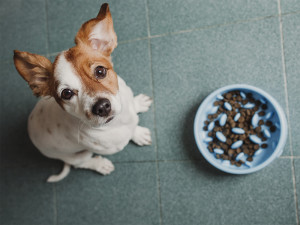What to Know About That Hot Spot on Your Dog
Unfortunately, we're talking about a ‘summer sore’, not a trendy east London nightclub

Share Article
For dogs – whose seasonal allergies are likely already flaring up, just like yours – hot spots can be a cause for summertime concern. Dogs and cats can suffer from hot spots anytime of the year, but some veterinarians have dubbed them ‘summer sores’ because they’re more common in super-hot and moist temperatures.
When a hot spot appears on your dog’s skin – one that’s red, flaky and sometimes full of puss – you’ll want to know how to treat it ASAP. Thankfully, there are lots of ways to remedy the topical infections at home, as long as they aren’t too serious. First and foremost, though, you have to be able to spot them. Below, a breakdown on how to do just that – plus, the different severities of hot spots on dogs, at-home treatments and, most importantly, when it’s time to seek professional help.

Get (totally free) deals for food, treats, accessories, tech and way more pet parenting must-haves.
What are hot spots on dogs?
A hot spot, referred to by vets as moist dermatitis or pyotraumatic dermatitis, is a common infection that happens when dogs chew, scratch, lick and gnaw at themselves, causing the skin’s normal bacteria to take over. In the first stages of formation, the skin becomes moist, red, itchy and infected. Pus begins to ooze from the traumatised skin as infection sets in. Then, dried pus and damaged skin will work to form a tightly adhered crust, and you’ll likely notice hair loss over the infection site. The formation of moist dermatitis can be a very painful process, and frequently, dogs will show pain when the area is touched.
Dogs are their own worst enemies when it comes to hot spots, which are generally created by their own overzealous self-licking and chewing. They can arise surprisingly quickly: a few minutes of ‘work’ can create some serious self-inflicted trauma. The good news is that hot spots almost always look worse than they actually are and infection is usually superficial – often resolved by topical treatment alone.
What causes hot spots on dogs?
So, what causes dogs to begin chewing and licking in the first place? Good question. The answer is anything that creates irritation on the skin, causing the dog to chew or scratch at the site. Insect bites (fleas, flies), skin allergies, excess skin-surface moisture, naturally heavy or dense coats, matted hair, saliva accumulation under the fur (read: the pet who’s always licking their feet), skin scrapes or excessive humidity in the environment can all be sources for a hot spot to develop. They can even be caused by a dog’s good old-fashioned boredom.
The location of the hot spots may help your vet determine their underlying cause. For example, a hot spot over the hip area could indicate flea infestation, hip arthritis or an anal gland infection. Similarly, a hot spot near an ear could indicate an ear problem, an allergy, or a dental or nerve irritation.
How to treat your dog’s hot spots at home
If the dog’s hot spot is small, non-painful, recognised early and uncomplicated, it may be possible to begin treatment at home with over-the-counter products such as topical sprays, medicated shampoos, herbal therapies and more. The important thing is to ensure that you’re using a pet-safe product, in which case it never hurts to call your veterinarian for approval. Whatever you do, do not use human topical products, as they may be toxic to dogs when licked and ingested. For example, zinc oxide, which is often found in human skin ointments, can be toxic for pups. Here are some at-home treatment basics:
If the area is small and non-painful, carefully and gently clip the fur covering the area; this allows air and medication to reach the wound. (Word of caution: use approved grooming clippers, not scissors. I see many ‘accidental lacerations’ in the surgery because of this.)
Keep your pet from licking the area. You guessed it: get out that cone of shame.
Apply a warm, moist compress to the area three times daily for five to 10 minutes to keep the area clean, calm the tissues and encourage good circulation. Allow the area to fully dry before applying anything topically.
Use only pet-safe, veterinary-approved over-the-counter treatments. As always, it’s best to consult with your vet prior to starting any home treatment.
Do not place any bandages or wraps to cover the area – you want the area to ‘breathe’.
Alleviate the itching or irritation that started the whole thing in the first place – get to the bottom of the source. Otherwise, you’ll be faced with a losing battle.
Tips for preventing hot spots on dogs
One thing that can’t be stressed enough is appropriate flea control. Good flea control is important for any itchy pet and is the foundation of itch prevention.
In hot, humid weather, always thoroughly dry your heavy-coated dog after bathing or swimming.
Make sure your dog is groomed on a regular basis.
Keep boredom and stress at bay. Provide adequate exercise and opportunities for mental stimulation and play.
Introduce essential fatty acids to your pet’s diet to help keep a healthy coat.
When it’s time to see a vet
The bad news is that about 30 percent of pets who develop hot spots actually have some other kind of skin disease, such as a deeper skin infection, a bite wound, or even immune-mediated disease. If you have any concerns whatsoever, it’s best to have your veterinarian assess them. Veterinary intervention may also be needed when the hot spot becomes so big and painful that it requires sedation to properly clip and clean.
Another potential concern is if a hot spot is accompanied by a deeper skin infection, which would require more extensive therapy such as oral pain medications, oral anti-inflammatory medications and oral antibiotics, in addition to topical treatments. The treatment your veterinarian chooses will depend on how bad the problem is, how much pain your dog is in, how long the problem has persisted and if the problem is a recurring one. Some dogs may get one or two hot spots and then never get another one again (lucky them), while others may have frequent recurrences.

Dr. Shea Cox, DVM, CVPP, CHPV
Dr. Shea Cox is the founder of BluePearl Pet Hospice and is a global leader in animal hospice and palliative care. With a focus on technology, innovation and education, her efforts are changing the end-of-life landscape in veterinary medicine.
Related articles
![a Chihuahua dog licking their paw]()
Why Is Your Dog Obsessed With Licking Their Paws?
Their toes might smell like Monster Munch, but there’s no way they taste that good
![]()
Scared Stiff: How to Spot Tetanus in Dogs
Dogs can get tetanus, too – and not just from rusty nails
![Puppy looks up while sitting next to a puzzle toy with food.]()
Tips to Slow Down a Dog Who Eats Too Fast
Eating fast is more than just unsightly – it’s potentially dangerous







